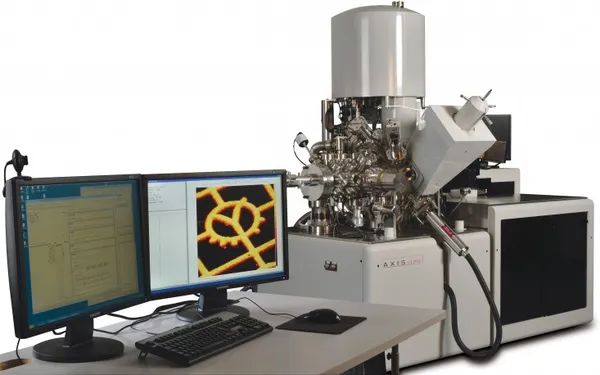Kratos Axis Ultra DLD
The AXIS Ultra DLD integrates the Kratos patented magnetic immersion lens and charge neutralisation system with the spherical mirror and concentric hemispherical analysers. Combined with the established delay-line detector (DLD) for both imaging and spectroscopy the AXIS Ultra DLD is the very best spectrometer for analysts requiring unsurpassed performance.

The hemispherical analyser provides both high energy resolution and high sensitivity spectroscopic performance. Exceptional small spot capabilities (<15µm) are achieved via a series of selected area apertures used in combination with the magnetic and electrostatic lenses. In parallel imaging mode photoelectrons are transferred to the patented spherical mirror analyser to produce real time chemical state images with less than 3µm spatial resolution.

The delay-line detector, comprising a multi-channel plate stack above a delay-line anode, is used for photoelectron detection in both spectroscopy and imaging modes. With over 100 detector channels the DLD can also be used to acquire unscanned or ‘snapshot’ small spot spectra in a matter of seconds. Genuine pulse counting in 2D imaging mode means that quantitative parallel images can now be generated allowing greater insight into the lateral distribution of chemical species at the surface.
Imaging XPS
The unique combination of the spherical mirror analyser and pulse counting DLD provides the ability to generate chemical images of the surface expressed in relative atomic concentration. Fast parallel imaging means that a set of quantitative images can be acquired in only a few minutes. The image below is from a patterned SiO2/Si sample with a photoresist material still present in the centre circle. Images were acquired in less than 16 minutes corresponding to oxygen, silicon oxide and elemental silicon peak positions. Subsequent data processing produces the relative atomic concentration image which can then be used to define the elemental and chemical composition as a function of position. Also shown is a line scan generated from a 2 pixel (3µm) wide line drawn across the image. Similarly, a quantification report can be generated from a group of pixels to give small spot information from areas only several microns square.

